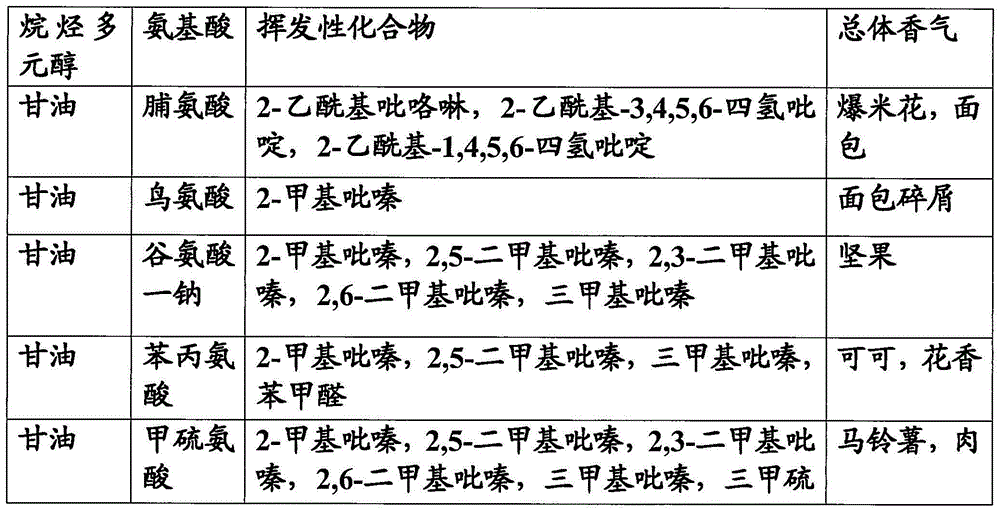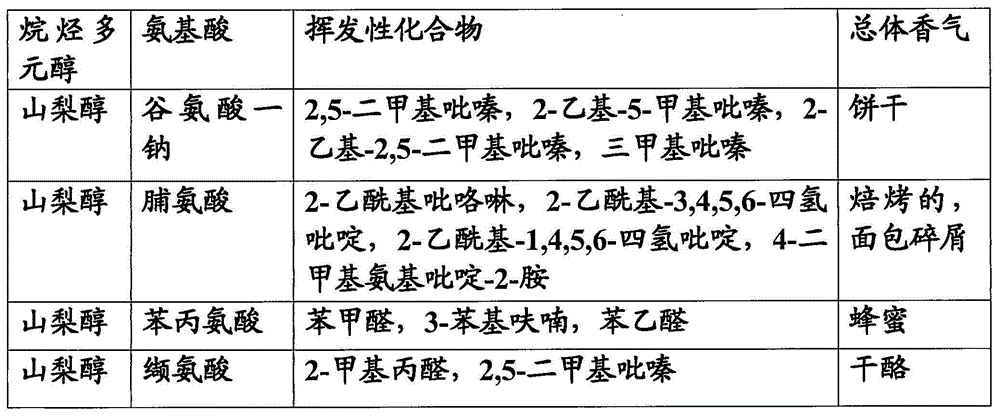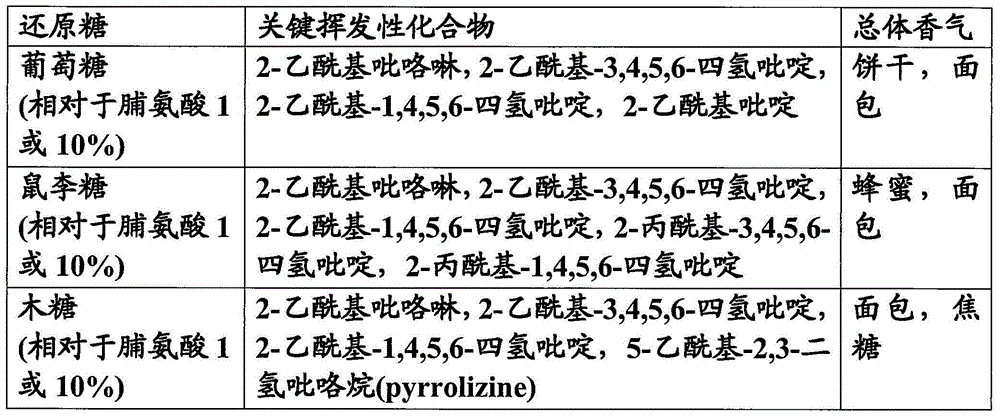Novel flavour compositions with improved flavour and/or flavour shelf-life
A fragrance composition and fragrance technology, applied in food science, dough processing, food ingredients as odor improvers, etc., can solve problems such as fragrance loss
- Summary
- Abstract
- Description
- Claims
- Application Information
AI Technical Summary
Problems solved by technology
Method used
Image
Examples
Embodiment 1
[0105] Example 1: Fragrance Compositions of the Invention Comprising Different Types of Amino Acids, Glycerin and Water
[0106] method
[0107] For the production of 45 exemplified by the amino acid proline gThe preparation method of the fragrance composition of the present invention: a mixture of proline (1.098g), glycerol (37.314g) and Vittel water (6.579g) was mechanically stirred at room temperature for 2h in a round bottom flask, and then preheated at 120°C. Heat in a hot oil bath for 2h.
[0108] Analytical method
[0109] The fiber (SPME Fiber PDMS-DVB 65 μm 23 gauge needle, Supelco N° 57345-U) was exposed to the headspace above the sample for 10 min at 30°C for 10 min at 30°C. After sampling, the fiber was transferred into the syringe hole in splitless mode for 5 min at 250°C to desorb and transfer the volatile compounds to the chromatography column. A 0.75mm i.d. sleeve (Supelco) was fitted to the syringe. Gas chromatography (GC) separation was performed using a...
Embodiment 2
[0116] Example 2: Fragrance Compositions of the Invention Comprising Different Types of Amino Acids, Sorbitol and Water
[0117] method
[0118] Preparation method for producing 4.1 g of the fragrance composition of the present invention exemplified by the amino acid monosodium glutamate: a mixture of monosodium glutamate (0.1 g), sorbitol (3.4 g) and Vittel water (0.6 g) in The round bottom flask was stirred mechanically at room temperature for 2 h, then heated in a preheated oil bath at 120 °C for 2 h.
[0119] Analytical method
[0120] The method described in Example 1 was applied.
[0121] aroma quality
[0122] The fragrance compositions were sensory evaluated as described in Example 1 by a panel of 5-10 members. Analyze and feel the results
[0123] Volatile analysis and specific sniffing were performed as described above. The results are shown in Table 2.
[0124] Table 2
[0125]
Embodiment 3
[0126] Example 3: Flavor compositions of the invention comprising different types of reducing sugars
[0127] method
[0128] The preparation method for producing 4.1 g of the fragrance composition of the present invention exemplified by the reducing sugar glucose: a mixture of proline (100.2 mg), glycerol (3409 mg), glucose (10.1 mg) and Vittel water (600 mg) was placed in a round bottom The flask was stirred mechanically at room temperature for 2 h, then heated in a preheated oil bath at 120° C. for 2 h.
[0129] Analytical method
[0130] The method described in Example 1 was applied.
[0131] aroma quality
[0132] The fragrance compositions were sensory evaluated as described in Example 1 by a panel of 3-6 members.
[0133] Analyze and feel the results
[0134] Volatile analysis and specific sniffing were performed as described above. The results are shown in Table 3.
[0135] table 3
[0136]
PUM
 Login to View More
Login to View More Abstract
Description
Claims
Application Information
 Login to View More
Login to View More - R&D
- Intellectual Property
- Life Sciences
- Materials
- Tech Scout
- Unparalleled Data Quality
- Higher Quality Content
- 60% Fewer Hallucinations
Browse by: Latest US Patents, China's latest patents, Technical Efficacy Thesaurus, Application Domain, Technology Topic, Popular Technical Reports.
© 2025 PatSnap. All rights reserved.Legal|Privacy policy|Modern Slavery Act Transparency Statement|Sitemap|About US| Contact US: help@patsnap.com



